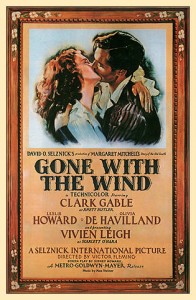
The 70th Anniversary of the Première of
1939 GONE WITH THE WIND 2009
Better late than never. 2009 is half over, and this year is, after all, the seventieth anniversary of the première, December 15, 1939, of Gone With the Wind.
Where to begin?—
Obviously at the top, with the Big Question: Is it the greatest movie ever made, as some public polls and critical pronouncements have indicated? . . . Be thinking about it. . . .
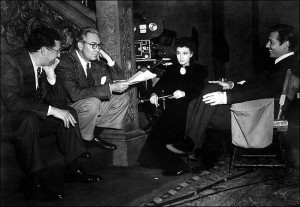 Among films, GWTW has one of the most turbulent histories, from the first time producer David O. Selznick read a synopsis of the book until the film was premièred in Atlanta, Georgia—the struggle with the script, first one writer then another, even Selznick himself contributing; the bewildering changes in directors, who were fired (George Cukor), became exhausted (Victor Fleming) or worked without credit (Sam Wood and William Cameron Menzies); the insistence by the principal female star that Margaret Mitchell’s dialogue be followed faithfully; the objections by the big-name male star to director Cukor, but only one reason why Cukor was replaced early on; the indifference of Leslie Howard, who didn’t want to make the film and had to be bribed; the last-minute rush to fabricate the background music, including tricks and threats to keep Max Steiner’s pen moving; the mounting—always mounting—expense of shooting endless hours of film—eighty-one hours according to one count, which had to be cut, cut, cut, cut and edited.
Among films, GWTW has one of the most turbulent histories, from the first time producer David O. Selznick read a synopsis of the book until the film was premièred in Atlanta, Georgia—the struggle with the script, first one writer then another, even Selznick himself contributing; the bewildering changes in directors, who were fired (George Cukor), became exhausted (Victor Fleming) or worked without credit (Sam Wood and William Cameron Menzies); the insistence by the principal female star that Margaret Mitchell’s dialogue be followed faithfully; the objections by the big-name male star to director Cukor, but only one reason why Cukor was replaced early on; the indifference of Leslie Howard, who didn’t want to make the film and had to be bribed; the last-minute rush to fabricate the background music, including tricks and threats to keep Max Steiner’s pen moving; the mounting—always mounting—expense of shooting endless hours of film—eighty-one hours according to one count, which had to be cut, cut, cut, cut and edited.
The film was finally reduced to a “mere” three hours and forty-two minutes.
Wheww-w-w——! That’s enough of that. Fatigue-inducing. Imagine Selznick’s fatigue! But he had Benzedrine and other drugs to keep him awake and at his usual full vigor.
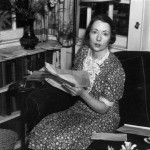 His fatigue was nothing compared to Margaret Mitchell’s. She had been working much longer on the novel, beginning as early as 1926, as the best research reveals, although even that year may be suspect. The writer—and reporter for the Atlanta Journal (now the Journal-Constitution)—was secretive by nature and a strict guardian of her privacy. Macmillan Company officially published the book June 30, 1936, though many people, as early as seven weeks before the formal release date, had read the galleys, even Kay Brown, Selznick’s New York agent. She sent Selznick a synopsis, adding, “Drop everything and buy it.”
His fatigue was nothing compared to Margaret Mitchell’s. She had been working much longer on the novel, beginning as early as 1926, as the best research reveals, although even that year may be suspect. The writer—and reporter for the Atlanta Journal (now the Journal-Constitution)—was secretive by nature and a strict guardian of her privacy. Macmillan Company officially published the book June 30, 1936, though many people, as early as seven weeks before the formal release date, had read the galleys, even Kay Brown, Selznick’s New York agent. She sent Selznick a synopsis, adding, “Drop everything and buy it.”
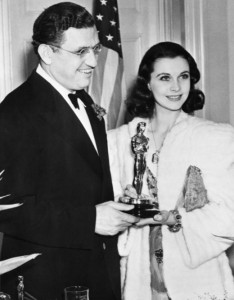 Selznick, whose ego was large enough for three or four men, wasn’t especially quick to embrace a project, rather deliberate and analytical when considering a new movie. He had begun reading GWTW in July of 1937 on a cruise to Honolulu for a vacation. He had his doubts at first—too big a canvas to put on film, too many characters, too expensive—but before long the book inspired him. Then possessed him. To the film, this frustrated perfectionist quickly became a guiding light, the worrisome custodian of both his dream creation, as he was already seeing it in his imagination, and the integrity of Margaret Mitchell’s ideal of her Southern plantation novel.
Selznick, whose ego was large enough for three or four men, wasn’t especially quick to embrace a project, rather deliberate and analytical when considering a new movie. He had begun reading GWTW in July of 1937 on a cruise to Honolulu for a vacation. He had his doubts at first—too big a canvas to put on film, too many characters, too expensive—but before long the book inspired him. Then possessed him. To the film, this frustrated perfectionist quickly became a guiding light, the worrisome custodian of both his dream creation, as he was already seeing it in his imagination, and the integrity of Margaret Mitchell’s ideal of her Southern plantation novel.
The new book received the widest range of criticism. It was, at the same time, one of the great Civil War novels and nothing more than a glorified soap opera, a “dramatic recreation of life itself” and an “old-fashioned Southern romance” done in a “commonplace” style. Whatever it was, however good, by the anniversary of its publication, sales totaled more than 1,7000,000 copies and had won the Pulitzer Prize.
Mitchell was exasperated by it all—first by last-minute changes in the book and proofreading more than a 1,000 pages and then, in the transfer to film, by dealing with all the “Hollywood folk” and the unsettling deviations, distortions and omissions despite the producer’s promised fidelity to the source.
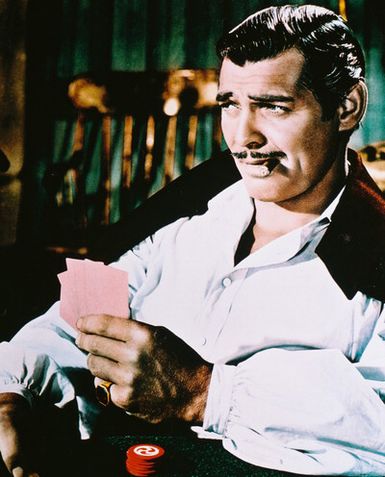 It was understood that Clark Gable was the only actor to play Rhett Butler—everyone who had read the book thought immediately of him—but to borrow the actor from M-G-M would be an expensive proposition. Selznick, as if in some self-deluding trance, went through the motions of considering Gary Cooper, Errol Flynn and Ronald Colman, all of whom, yes, now seem decidedly wrong for the role. The producer must have known that, in the end, he would have to figure some way, pay whatever the price, make whatever concessions to acquire the services of Gable.
It was understood that Clark Gable was the only actor to play Rhett Butler—everyone who had read the book thought immediately of him—but to borrow the actor from M-G-M would be an expensive proposition. Selznick, as if in some self-deluding trance, went through the motions of considering Gary Cooper, Errol Flynn and Ronald Colman, all of whom, yes, now seem decidedly wrong for the role. The producer must have known that, in the end, he would have to figure some way, pay whatever the price, make whatever concessions to acquire the services of Gable.
As for Scarlet, practically every Hollywood actress of the approximate right age was tested, including Jean Arthur, Madeleine Carroll, Joan Bennett and Paulette Goddard. Even those who would have been ludicrous in the role went before the cameras, either in color or black and white—Tallulah Bankhead because she was a Southerner and had the prerequisite accent, and the inexperienced, unsophisticated and ridiculously young sixteen-year-old Anne Baxter.
At the same time, Warner Bros. was pushing a package deal with Bette Davis and Errol Flynn, but Davis had said up front that she wouldn’t consider acting opposite Flynn, though she coveted the role as much as any actress in Hollywood. “ . . . I knew Flynn was not good casting as Rhett Butler,” she wrote years later in Mother Goddam, “and therefore my performance would be hampered.”
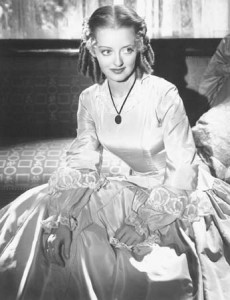 Davis did have partial revenge, playing a Scarlett-like Southern belle and winning her second Oscar in Jezebel, released the year before GWTW. In its setting, time frame, plot and some of the scenes, the film was a foretaste of GWTW, and Selznick accused WB of plagiarism. In Jezebel, besides the imagined scent of magnolias, the air is heavy with exaggerated Southern accents—from Henry Fonda, Fay Bainter, Donald Crisp, George Brent, Spring Byington, Henry O’Neil. Everybody! This “heaviness” is less evident in GWTW, perhaps because the accents are more natural, those of Ashley and Melanie subtle and because, from the start, Gable had refused to affect any accent whatsoever.
Davis did have partial revenge, playing a Scarlett-like Southern belle and winning her second Oscar in Jezebel, released the year before GWTW. In its setting, time frame, plot and some of the scenes, the film was a foretaste of GWTW, and Selznick accused WB of plagiarism. In Jezebel, besides the imagined scent of magnolias, the air is heavy with exaggerated Southern accents—from Henry Fonda, Fay Bainter, Donald Crisp, George Brent, Spring Byington, Henry O’Neil. Everybody! This “heaviness” is less evident in GWTW, perhaps because the accents are more natural, those of Ashley and Melanie subtle and because, from the start, Gable had refused to affect any accent whatsoever.
The discovery of the true, irrefutable and ultimate Scarlett ranks with the alleged discovery of Lana Turner sitting at the soda fountain in a sweater at Schwab’s Drug Store. Almost a year to the day before the première of the film, the “burning of Atlanta”—not the city on fire but ordnance ignited by the Confederates—was filmed on Forty Acres, the studio back lot. Myron Selznick, David’s brother and a talent agent, was present that night, and, in the glow of the flames, said he wanted to introduce him to his Scarlett.
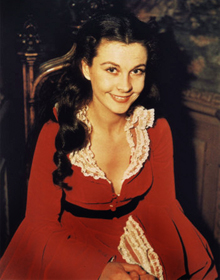 That’s the legend—one version at least—of how an English girl came to be the Scarlett. The actress had read the book before she crossed the Atlantic, memorized much of it and knew somehow, even then, she was destined to play the role. Another legend? Er, maybe. Some years later, Selznick would say, “I took one look and knew that she was right—at least right as far as her appearance went—at least right as far as my conception of how Scarlett O’Hara looked.”
That’s the legend—one version at least—of how an English girl came to be the Scarlett. The actress had read the book before she crossed the Atlantic, memorized much of it and knew somehow, even then, she was destined to play the role. Another legend? Er, maybe. Some years later, Selznick would say, “I took one look and knew that she was right—at least right as far as her appearance went—at least right as far as my conception of how Scarlett O’Hara looked.”
No matter that the opening line of the novel clearly states that “Scarlett O’Hara was not beautiful . . . ,” Vivien Leigh was beautiful, one of the great beauties of film history—not in the bathing beauty sense (Vivien was quite flat-chested), but in the magic, the fire, in her eyes and the radiance of her face, accented, as so often in GWTW, by elegant dresses and hats. She could have posed for Jean Baptiste Greuze and, with little change, become his Young Woman In a White Hat, the eighteenth-century French portrait.
That her beauty contradicted the book bothered nobody, nor that she was English, especially since the Englishness was lost in her mastery of the Southern accent. The shared qualities of Leigh and Scarlett—charm, passion, determination and, yes, selfishness—were scarily merged on screen. And the Southern community was much relieved by the choice of Vivien Leigh: at least Scarlett wasn’t played by a Yankee girl!
“There was a land of Cavaliers and Cotton Fields called the Old South. . . .
Here in this prettyworld Gallantry took its last bow. . . .
Here was the last ever to be seen of Knights and their Ladies Fair, of Master and of Slave. . . .
Look for it only in books, for it is no more than a dream remembered.
A Civilization gone with the wind. . . . ”
—Not from the book but penned by David O. Selznick himself for the prologue of the movie
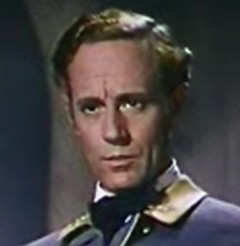 Leslie Howard, who didn’t want any part of GWTW, who learned only his lines and never read the book, though Selznick begged him, was ultimately bribed to play Ashley Wilkes by the producer’s promise that he could direct a forthcoming film, Intermezzo. Howard was much too old for the part and much was done to hide the age lines in his face; despite the many adjustments, the yellowing of his hair doesn’t seem natural, in color or texture.
Leslie Howard, who didn’t want any part of GWTW, who learned only his lines and never read the book, though Selznick begged him, was ultimately bribed to play Ashley Wilkes by the producer’s promise that he could direct a forthcoming film, Intermezzo. Howard was much too old for the part and much was done to hide the age lines in his face; despite the many adjustments, the yellowing of his hair doesn’t seem natural, in color or texture.
Leslie Howard was the second of those involved with GWTW to die; his KLM airline was shot down by a Nazi fighter in 1943. His death was mentioned in the American film Bright Victory (1951). The first great tragedy of the film, before it was finished, was the death of writer Sidney Howard, in a tractor accident on his Pennsylvania farm. From among the many script contributors, including Ben Hecht and Selznick himself, Howard received the screenplay credit.
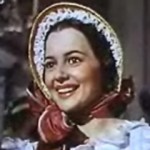 And the fourth of the lead performers—fourth in screen credit order, anyway? Olivia de Havilland, famous for making eight Errol Flynn movies between 1935 and 1941, was the logical choice for the role of Melanie Hamilton. There were no other contenders, and she ideally suits the part, partially because the required qualities of sweetness, sincerity and humility were very much her own. She celebrated her ninety-third birthday in 2009. Ann Rutherford, who was born in 1920, and Cammie King, the movie offspring of Scarlett and Rhett, are among the other surviving stars.
And the fourth of the lead performers—fourth in screen credit order, anyway? Olivia de Havilland, famous for making eight Errol Flynn movies between 1935 and 1941, was the logical choice for the role of Melanie Hamilton. There were no other contenders, and she ideally suits the part, partially because the required qualities of sweetness, sincerity and humility were very much her own. She celebrated her ninety-third birthday in 2009. Ann Rutherford, who was born in 1920, and Cammie King, the movie offspring of Scarlett and Rhett, are among the other surviving stars.
The first preview screening of GWTW is a story in itself and deserves retelling for the few who might not know it. With twenty-four cans of unedited film, with some process shots still necessary and without a final score (Alfred Newman’s The Prisoner of Zenda was dubbed in), David, his wife, Irene, Myron and one of the film editors, Ken Kern, appeared unannounced at a theater in Riverside, some fifty miles southeast of Hollywood.
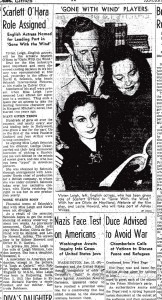 The manager was told there would be a special preview of a new picture. Members of the audience could leave before the film began, and those who remained would not be permitted to leave until after the screening. There were to be no phone calls. The manager wanted to call his wife to come; Kern said he could but without explaining why. A boy, William Erickson, who had come with his parents to see Beau Geste, part of the scheduled double feature, decided to remain.
The manager was told there would be a special preview of a new picture. Members of the audience could leave before the film began, and those who remained would not be permitted to leave until after the screening. There were to be no phone calls. The manager wanted to call his wife to come; Kern said he could but without explaining why. A boy, William Erickson, who had come with his parents to see Beau Geste, part of the scheduled double feature, decided to remain.
As soon as the title came on the screen, for the white gliding letters had recently been added by Pacific Title, the audience erupted in a frenzy, screaming, cheering, applauding, jumping up on the seats. Kern, who was operating a remote sound box, had the volume full but what emanated from the screen was overwhelmed. The Hollywood visitors were in tears. At the end of the film, the audience repeated their verbal enthusiasm and appreciation; the preview cards were unanimously positive, with pleas not to cut the film. There had never been such a reaction to a screening. It was the greatest moment of Selznick’s life.
And little Billy? He asked his mom if, now, could he see Beau Geste!
“I think it’s hard winning a war with words, gentlemen. . . . I mean . . . there’s not a cannon factory in the whole South. . . . I’m afraid it’s going to make a great deal of difference to a great many gentlemen, sir. . . . No, I’m not hinting [that the Yankees can ‘lick us’]. I’m saying very plainly that the Yankees are better equipped than we. They’ve got factories, shipyards, coal mines and a fleet to bottle up our harbors and starve us to death. All we’ve got is cotton and slaves and—arrogance.”
—Rhett Butler’s speech to the war-anxious Southern men in the library of Twelve Oaks.
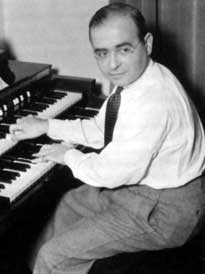 The preceding has been only a part of the GWTW story—there is so much more—but one last aspect of the film’s magic and fascination needs mention: Max Steiner’s score. With Selznick’s prodding, the composer finally finished the music, with the aid of Adolph Deutsch, Hugo Friedhofer and Heinz Roemheld—and at least forty Civil War, patriotic, religious, traditional and classical tunes which are laced into the score. Despite some effective moments—the choral arrangement of “Dixie” behind Selznick’s “Cavaliers and Cotton Fields” epitaph and the Sherman montage—it is a patchwork, its tie to GWTW of greater importance than its musical worth. Still, the “Tara” theme endures as one of the most famous movie tunes.
The preceding has been only a part of the GWTW story—there is so much more—but one last aspect of the film’s magic and fascination needs mention: Max Steiner’s score. With Selznick’s prodding, the composer finally finished the music, with the aid of Adolph Deutsch, Hugo Friedhofer and Heinz Roemheld—and at least forty Civil War, patriotic, religious, traditional and classical tunes which are laced into the score. Despite some effective moments—the choral arrangement of “Dixie” behind Selznick’s “Cavaliers and Cotton Fields” epitaph and the Sherman montage—it is a patchwork, its tie to GWTW of greater importance than its musical worth. Still, the “Tara” theme endures as one of the most famous movie tunes.
And the Big Question. Is GWTW the greatest movie ever made? Maybe. Some movie buffs and critics would suggest its frequent challenger, at least among American films, Citizen Kane. That could be, too. Other folks would nominate a foreign masterpiece. Kane, though—and it’s a guarded “though”—is the kind of film which has to be practically studied, by all means seen repeatedly, to be fully appreciated. Kane is a stunning demonstration of cinematic technique and the subtleties of photography, though GWTW does occasionally impress in this area. There is, for one, the famous crane shot—construction crane, that is (this is, after all, 1939)—of Scarlett walking among the wounded at the railroad station.
Selznick’s little film, more easily than Kane, can be a relaxed enjoyment, a slice of life the way many people might know it. Perhaps Leonard Maltin (and/or his staff) hits the middle ground best: “If not the greatest movie ever made, certainly one of the greatest examples of storytelling on film, maintaining interest for nearly four hours.” (For excellent reviews of both GWTW and Kane, consult Roger Ebert’s The Great Movies, Vol. I.)
Even if not the greatest film of them all—what a movie, what a history and story, what a viewing experience, what nostalgia! It’s one of the few films in which a rather morbid game is played against time, especially by those who saw the film when it was new and somehow tie their lives to the life of GWTW—on the left page of the ledger, the players who still survive, on the right, those who have departed. As always—perpetually!—time moves on, and the left page has fewer and fewer names, while the right side— The game, one should expect, is about over.
David O. Selznick tried to duplicate his success, to make another masterpiece. In the first try the material disappointed, the sweep and all the elements that had come together in GWTW, after such struggle and upheaval, were missing. Duel In the Sun (1946) is bloated, the unpleasant telling of a sordid love story, often derided as Lust In the Dust. By the time of A Farewell to Arms (1957), a boring, inept and unnecessary remake, the Selznick inspiration had been drained and, as he well knew, Hollywood had changed since 1939—and not for the better. Arms was the last film Selznick produced.
His obituary, as he had always said, would tie him, in the same line, to GWTW. Sure enough, the morning after his death, June 22, 1965, the New York Times bore this headline:
David O. Selznick, 63, Producer of Gone With the Wind, Dies.
So what was “Birth of a Nation”? Both epics were Klan fodder!